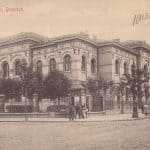
Casa Capșa is a hotel complex, situated on Calea Victoriei, at the crossroad with Edgar Quintet Street. The complex consists of the hotel, a bakery, a cafeteria and the Capșa restaurant, and was, at some point, the biggest chain of restaurants and bakeries of the country, becoming well-known in the entire Europe.
At the end of the 17th century, the land that Casa Capșa is on today was occupied by the houses and the grounds of Radu Slătineanu. In 1830, the houses were bought by the italian Eronimo Momolo, who opens a restaurant that will quickly become famous for its’ italian cuisine, with oriental influences. Above the restaurant will be opened, in 1936, a ballroom, where the most elegant events of the times will take place.
In 1868, the ownership changes once again, being bought by Constantin and Grigore Capșa, who will open here a bakery, named ”La doi frați, Constantin și Grigore Capșa”. Constantin is going to retire after 8 years, leaving Grigore to tend the business. He builds a hotel here, in 1886, and a cafe, in 1891.
In 1869, Casa Capșa becomes the official provider of the Ruler’s Court, as well as other royal houses, in Bulgaria and Serbia. Its’ success leads to the inauguration of some chocolate and candy factories. Casa Capșa is prohibited for the intellectuals until the First World War, when it will be used as an officer’s mess for bulgarian soldiers.
Casa Capșa is modified in 1931, after the death of Grigore Capșa, in a limited partnership, because of legal issues. The firm is nationalised in 1948.
The Capșa Bakery has always had the highest standards, and the followers of Grigore Capșa were constantly travelling to Paris in order to get samples of the newest bakery products, so Capșa would always have new products. A very well-known habit here was selling the bakery products left from the previous day to the staff, at production cost. A lot of people were brought from Paris to work here, among them being even chefs and bakers.
Casa Capșa was a very important place for romanian personalities and foreign guests: it was the place where writers, diplomats or government figures would meet. Another tradition was to launch a new house specialty (bakery or pastries) whenever a dinner for important people would happen. This still happens today.
Casa Capșa changes the type of clients they serve after the Second World War, becoming the favourite place of intellectuals, like writers, painters and artists. In 1975, the building is restored, and the hotel is reopened, after its’ closing in 1948, as a result of the nationalisation. The cafe becomes once again a place of meeting for high-class people, and in 1990 it is again declared private property, regaining the name of Casa Capșa and going through another process of restoration.
Casa Capșa was for a long time the best bakery in Europe, often bringing in sweets from Paris or Oriental ones, and it’s a representative building for the Bucharest of yesterday.
Telephone Palace
The Telephone Palace was built on Calea Victoriei between 1929 and 1933, following the architecture used for the construction of skyscrapers in the United States. The building is 52,5 meters tall and, at the time of writing, hosts the main offices of the Telekom company.
The place on which the Palace was built belonged to the Oteteleșanu Terrace, one of the most popular gardens of the capital at the end of the 1800s. Around 1930, the terrace lost its’ charm and was bought by the Telephone Society.
The project is realized by 3 foreign architects, one of them (Edmond van Saanen Algi) also being the one who projected the Academy of Economical Studies. The construction took place in a relatively short time, only 20 months, being finished in 1933. The Palace was built in an Art Deco style, and before the 1970s, it was the tallest building in Bucharest. It was also the first tall building to be constructed on a steel skeleton in Romania.
The Telephone Palace was inaugurated in 1934, in the presence of King Carol the 2nd. In sunny days, the roof of the Telephone Palace was one of the few places in the capital from where you could see the mountains. The building resisted to the earthquakes of 1940, 1977, 1986 and 1990 and survived the airstrikes of 1944, when it was one of the targets of the German air force. They missed, however, and the old building of the National Theatre was hit instead.
As a result of these events and some problems discovered in the way the roof was built (it wasn’t projected to sustain antennas like the ones used by telephone companies), the Palace has entered an ample process of renovation and reconstruction, between 1995 and 2005. It was one of the biggest architectural projects of reconstruction in Romania.
The Telephone Palace is one of the symbols of Bucharest, being resistant throughout the years and different events that happened on the course of its life.


